What began as a celebration of National Drop Everything and Read (D.E.A.R.) Day on April 12—the birthday of popular children’s book author Beverly Cleary—has become an annual month-long celebration. Here is a selection of recently published books to add to classroom libraries to encourage independent reading. Join the celebration by setting aside time for students to read in class every day during April or, better yet, all year long.
Ages 4–8
The Adventures of Wrong Man and Power Girl! C. Alexander London. Ill. Frank Morrison. 2018. Philomel/Penguin.
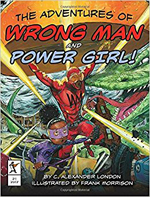 Never fear! Wrong Man is here! Or maybe not. In this adventure story, illustrated with a father–daughter duo of super hero character in comic book fashion, Wrong Man does exactly the opposite of what is needed to rescue people from catastrophes, such as a meteor heading toward the city, a fire, a bank robbery, and even homework-eating dogs! However, Power Girl is always there to save the day. This is a heartwarming story of the loving relationship between a daughter and her dad, with an ending that assures readers “even Wrong Man is right sometimes.”
Never fear! Wrong Man is here! Or maybe not. In this adventure story, illustrated with a father–daughter duo of super hero character in comic book fashion, Wrong Man does exactly the opposite of what is needed to rescue people from catastrophes, such as a meteor heading toward the city, a fire, a bank robbery, and even homework-eating dogs! However, Power Girl is always there to save the day. This is a heartwarming story of the loving relationship between a daughter and her dad, with an ending that assures readers “even Wrong Man is right sometimes.”
—SK
City Cycle. Alison Farrell. 2018. Chronicle.
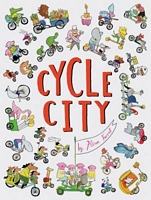 It’s the morning of Cycle City’s Starlight Parade, and Mayor Snail is helping the parade committee deliver eight last-minute invitations. It’s not an easy task as everyone moves around the bustling city on wheels. Double-page spreads provide panoramic city scenes (reminiscent of Richard Scarry’s books) filled with animal citizens riding different kinds of cycles. Footnotes provide clues and ask readers to help the mayor find the individuals he needs to invite. Mission accomplished, it’s time for the parade to begin. The back endpaper identifies the cycles featured in this delightful seek-and-find book.
It’s the morning of Cycle City’s Starlight Parade, and Mayor Snail is helping the parade committee deliver eight last-minute invitations. It’s not an easy task as everyone moves around the bustling city on wheels. Double-page spreads provide panoramic city scenes (reminiscent of Richard Scarry’s books) filled with animal citizens riding different kinds of cycles. Footnotes provide clues and ask readers to help the mayor find the individuals he needs to invite. Mission accomplished, it’s time for the parade to begin. The back endpaper identifies the cycles featured in this delightful seek-and-find book.
—CA
Hello, Door. Alastair Heim. Ill. Alisa Coburn. 2018. Little Bee.
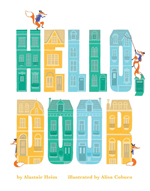 A bushy-tailed red fox stealthily approaches an elegant house and enters through a window. Moving through rooms, he greets objects with a “Hello” and stashes valuables into his big sack. Finding a huge jewelry box in an upstairs bedroom, he exclaims, “Hello, necklace. / Hello, rings. / HELLO, OTHER SPARKLY THINGS.” Then, with sack bulging, the bejeweled thief is on his way out. “Bye-bye, bedroom. / Bye-bye stairs. / Bye-bye, mirror. / Bye-bye . . . / . . . BEARS?!?” After being pursued through the house, the empty-handed fox is tossed out a window by Madame Bear. Lesson learned? Probably not. The final spread shows the fox approaching an even grander house. “Hello, door!” There’s more to discover in the richly detailed cartoon illustrations—including clues about the residents of the burgled house—with each rereading.
A bushy-tailed red fox stealthily approaches an elegant house and enters through a window. Moving through rooms, he greets objects with a “Hello” and stashes valuables into his big sack. Finding a huge jewelry box in an upstairs bedroom, he exclaims, “Hello, necklace. / Hello, rings. / HELLO, OTHER SPARKLY THINGS.” Then, with sack bulging, the bejeweled thief is on his way out. “Bye-bye, bedroom. / Bye-bye stairs. / Bye-bye, mirror. / Bye-bye . . . / . . . BEARS?!?” After being pursued through the house, the empty-handed fox is tossed out a window by Madame Bear. Lesson learned? Probably not. The final spread shows the fox approaching an even grander house. “Hello, door!” There’s more to discover in the richly detailed cartoon illustrations—including clues about the residents of the burgled house—with each rereading.
—CA
Prickly Hedgehogs! Jane McGuinness. 2018. Candlewick.
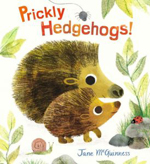 “Someone’s sniffling and snuffling and snaffling . . . whirring and churring and purring.” It’s a prickly hedgehog. With engaging text (accompanied by insets of related facts) and mixed-media full-page and paneled illustrations, Jane McGuinness introduces a mother hedgehog and her five hoglets, who are ready to leave the nest, learn to hunt for food, and learn to live independently. Little Hedgehog eats and eats on nocturnal forays, getting fatter and fatter, and at the end of fall makes a nest in preparation for hibernation through the winter. Back matter includes a “More About Hedgehogs” page, an index, and sources for more information.
“Someone’s sniffling and snuffling and snaffling . . . whirring and churring and purring.” It’s a prickly hedgehog. With engaging text (accompanied by insets of related facts) and mixed-media full-page and paneled illustrations, Jane McGuinness introduces a mother hedgehog and her five hoglets, who are ready to leave the nest, learn to hunt for food, and learn to live independently. Little Hedgehog eats and eats on nocturnal forays, getting fatter and fatter, and at the end of fall makes a nest in preparation for hibernation through the winter. Back matter includes a “More About Hedgehogs” page, an index, and sources for more information.
—CA
Rabbit Moon. Jean Kim. 2018. Arthur A. Levine/Scholastic.
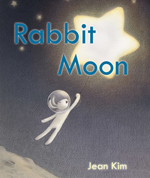 In her debut picture book, Jean Kim draws inspiration from her own heritage and Korean folklore to tell the story of the rabbit on the moon. Far away, Raccoon and his animal friends make wishes that set sail as paper airplanes into the night sky. Rabbit holds a magical mortar and pestle with which he grinds the wishes into stars. However, he has his own wishes, and decides to leave the moon to visit these new friends. As together they watch the stars disappear into a black night, rabbit leaves and returns to the moon where he magically turns the dark sky into a sparkly sky full of stars for his friends to see. This beautifully illustrated story about wishes, friendships, and adventure is perfect for encouraging young children to think about what they see when they look at the moon.
In her debut picture book, Jean Kim draws inspiration from her own heritage and Korean folklore to tell the story of the rabbit on the moon. Far away, Raccoon and his animal friends make wishes that set sail as paper airplanes into the night sky. Rabbit holds a magical mortar and pestle with which he grinds the wishes into stars. However, he has his own wishes, and decides to leave the moon to visit these new friends. As together they watch the stars disappear into a black night, rabbit leaves and returns to the moon where he magically turns the dark sky into a sparkly sky full of stars for his friends to see. This beautifully illustrated story about wishes, friendships, and adventure is perfect for encouraging young children to think about what they see when they look at the moon.
—SK
This Zoo Is Not for You. Ross Collins. 2018. Candlewick.
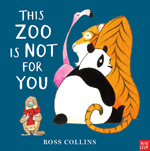 A platypus enters a zoo with an envelope in his hand. There is a notice on the entry gate that says “Interviews Today. Apply Within.” As he meets with various animals (a panda, flamingoes, monkeys, chameleons, and an elephant) they brag about what makes them so special and point out reasons why Platypus doesn’t belong there. As the platypus turns around to leave, the animals start to feel bad about how they treated him and decide that he really could have joined their zoo. But what to do? The illustrations show monkey finding the envelope that the platypus dropped on his way out. The animals discover they were quick to judge, and that his intentions weren’t at all what they assumed. The rhyming text and colorful illustrations (done in watercolor and charcoal) make this a pleasing story with a gentle lesson about jumping to conclusions, acceptance, and friendship.
A platypus enters a zoo with an envelope in his hand. There is a notice on the entry gate that says “Interviews Today. Apply Within.” As he meets with various animals (a panda, flamingoes, monkeys, chameleons, and an elephant) they brag about what makes them so special and point out reasons why Platypus doesn’t belong there. As the platypus turns around to leave, the animals start to feel bad about how they treated him and decide that he really could have joined their zoo. But what to do? The illustrations show monkey finding the envelope that the platypus dropped on his way out. The animals discover they were quick to judge, and that his intentions weren’t at all what they assumed. The rhyming text and colorful illustrations (done in watercolor and charcoal) make this a pleasing story with a gentle lesson about jumping to conclusions, acceptance, and friendship.
—SK
Ages 9–11
Hope in the Holler. Lisa Lewis Tyre. 2018. Nancy Paulsen/Penguin.
 Wavie’s beloved mom left her a list of instructions just before she died, hoping to help her move on with her life. Wavie is in for a big surprise, however, when she is whisked away from the cemetery and taken to Conley Hollow in Appalachia by a mean and mysterious aunt. Living in squalor, poverty, and a world of abuse, Wavie knows she has no choice but to live with this evil woman. Amid her troubles and grief for her mom, Wavie makes friends with Gilbert and Camille, who help her live by her mom’s advice: “Be brave, Wavie B! You got as much right to a good life as anybody, so find it!”
Wavie’s beloved mom left her a list of instructions just before she died, hoping to help her move on with her life. Wavie is in for a big surprise, however, when she is whisked away from the cemetery and taken to Conley Hollow in Appalachia by a mean and mysterious aunt. Living in squalor, poverty, and a world of abuse, Wavie knows she has no choice but to live with this evil woman. Amid her troubles and grief for her mom, Wavie makes friends with Gilbert and Camille, who help her live by her mom’s advice: “Be brave, Wavie B! You got as much right to a good life as anybody, so find it!”
—SK
The Ultimate Book of Sharks: Your Guide to These Fierce and Fantastic Fish. Brian Skerry. 2018. National Geographic Society.
 National Geographic explorer and photographer Brian Skerry takes readers on an underwater adventure to learn about the diversity and fantastic features of sharks. Eight chapters cover topics such as types of sharks, shark anatomy, shark myths, fossils, and shark conservation. Each chapter contains a wealth of captioned full-color photographs and text organized in brief paragraphs and charts. Special features include dramatic “Moments of AHHH!?!!,” close-up photographs, “Shark Bites” of trivia, and “Skerry Encounters” highlighting personal insights from Skerry on his interactions with sharks.
National Geographic explorer and photographer Brian Skerry takes readers on an underwater adventure to learn about the diversity and fantastic features of sharks. Eight chapters cover topics such as types of sharks, shark anatomy, shark myths, fossils, and shark conservation. Each chapter contains a wealth of captioned full-color photographs and text organized in brief paragraphs and charts. Special features include dramatic “Moments of AHHH!?!!,” close-up photographs, “Shark Bites” of trivia, and “Skerry Encounters” highlighting personal insights from Skerry on his interactions with sharks.
—CA
The United States v. Jackie Robinson. Sudipta Bardhan-Quallen. Ill. R. Gregory Christie. 2018. Balzer + Bray/HarperCollins.
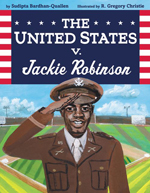 Readers may know that Jackie Robinson broke the color line in Major League Baseball on April 15, 1947, when he played with the Brooklyn Dodgers against the Boston Braves at Ebbets Field. However, many are unaware of his resistance to discrimination while serving as a second lieutenant during World War II. Like many other black soldiers, he experienced racism daily. Despite an army’s order forbidding segregation on military posts and buses, on July 6, 1944, at Fort Hood, Texas, Robinson was arrested for refusing to move to the back of an army bus. On August 2, his court-martial began. The verdict: Not guilty. Robinson had fought for what he knew was right and won. Back matter includes a timeline, an author’s note, and bibliography.
Readers may know that Jackie Robinson broke the color line in Major League Baseball on April 15, 1947, when he played with the Brooklyn Dodgers against the Boston Braves at Ebbets Field. However, many are unaware of his resistance to discrimination while serving as a second lieutenant during World War II. Like many other black soldiers, he experienced racism daily. Despite an army’s order forbidding segregation on military posts and buses, on July 6, 1944, at Fort Hood, Texas, Robinson was arrested for refusing to move to the back of an army bus. On August 2, his court-martial began. The verdict: Not guilty. Robinson had fought for what he knew was right and won. Back matter includes a timeline, an author’s note, and bibliography.
—CA
Ages 12–14
Mapping the Bones. Jane Yolen. 2018. Philomel/Penguin.
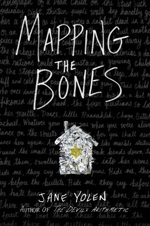 Jane Yolen once again transports readers to the troubling scene of World War II, the Lodz Ghetto, and the unmanageable horrors of the Holocaust, as depicted in her award-winning The Devil’s Arithmetic (1988)and Briar Rose (1992). Fourteen-year-old twins Chaim and Gittel communicate with each other through their private sign language. Chaim, who stutters, also expresses his thoughts and fears through poetry he composes in his mind. When word comes that their family is about to receive a “wedding invitation” (code for being transferred to a camp), the family escapes and makes arrangements with partisans to transport Chaim and Gittel to safety. Yolen’s historical novel, with overtones of a dark Hansel and Gretel,will have readers marveling at Chaim and Gittel’s will to survive the horror that has become their new reality—as it reminds them to never forget.
Jane Yolen once again transports readers to the troubling scene of World War II, the Lodz Ghetto, and the unmanageable horrors of the Holocaust, as depicted in her award-winning The Devil’s Arithmetic (1988)and Briar Rose (1992). Fourteen-year-old twins Chaim and Gittel communicate with each other through their private sign language. Chaim, who stutters, also expresses his thoughts and fears through poetry he composes in his mind. When word comes that their family is about to receive a “wedding invitation” (code for being transferred to a camp), the family escapes and makes arrangements with partisans to transport Chaim and Gittel to safety. Yolen’s historical novel, with overtones of a dark Hansel and Gretel,will have readers marveling at Chaim and Gittel’s will to survive the horror that has become their new reality—as it reminds them to never forget.
—SK
Rising Above: Inspiring Women in Sports. Gregory Zuckerman (with Gabriel Zuckerman & Elijah Zuckerman). 2018. Philomel/Penguin.
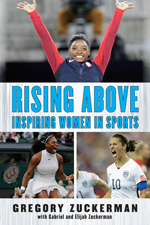 In this collective biography of 10 female U.S. athletes, the author and his two sons relate how each woman overcame various obstacles to attain world-class athletic achievement. Gymnast Simone Biles was taken from her mother and lived in a foster home until her grandparents adopted her. Ronda Rousey had to deal with her father’s suicide, then bullying as her body became stronger and more athletic with judo lessons. Carli Lloyd was cut from her college soccer team. And Wilma Rudolph, stricken with polio at age four, was born into a poor African American family in the segregated South. Each of these mini biographies will engage and inspire readers. Back matter includes an afterword on the author’s experiences in interviewing these women, a bibliography for each athlete, and an index.
In this collective biography of 10 female U.S. athletes, the author and his two sons relate how each woman overcame various obstacles to attain world-class athletic achievement. Gymnast Simone Biles was taken from her mother and lived in a foster home until her grandparents adopted her. Ronda Rousey had to deal with her father’s suicide, then bullying as her body became stronger and more athletic with judo lessons. Carli Lloyd was cut from her college soccer team. And Wilma Rudolph, stricken with polio at age four, was born into a poor African American family in the segregated South. Each of these mini biographies will engage and inspire readers. Back matter includes an afterword on the author’s experiences in interviewing these women, a bibliography for each athlete, and an index.
—SK
Ages 15+
Fum. Adam Rapp. 2018. Candlewick.
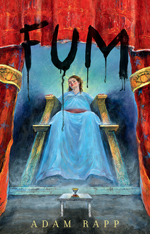 Corinthia Bledsoe is not your average Midwestern high school junior. She’s over seven feet tall, wears size 22 shoes, is extremely bright, and can predict doom and gloom—such as a tornado that will hit her high school, leaving a cow standing in the middle of the Lugo Memorial field house. Corinthia has other storms brewing in her life, not the least of which are school bullies, teachers, and her own mother, who unable to come to terms with her daughter’s size, joins a support group for parents of grossly deformed children. Readers will follow Corinthia as she deals with her increasingly dysfunctional family, physical challenges, and an admirer at school who is facing his own challenges. Reading like a dark fairy tale, this book has an ending that may be somewhat happily-ever-after following a strange and surprising turn of events.
Corinthia Bledsoe is not your average Midwestern high school junior. She’s over seven feet tall, wears size 22 shoes, is extremely bright, and can predict doom and gloom—such as a tornado that will hit her high school, leaving a cow standing in the middle of the Lugo Memorial field house. Corinthia has other storms brewing in her life, not the least of which are school bullies, teachers, and her own mother, who unable to come to terms with her daughter’s size, joins a support group for parents of grossly deformed children. Readers will follow Corinthia as she deals with her increasingly dysfunctional family, physical challenges, and an admirer at school who is facing his own challenges. Reading like a dark fairy tale, this book has an ending that may be somewhat happily-ever-after following a strange and surprising turn of events.
—SK
Susan Knell is a professor in the Department of Teaching and Leadership at Pittsburg State University in Pittsburg, Kansas, where she teaches literacy and literature courses at the undergraduate and graduate level. Carolyn Angus is former director of the George G. Stone Center for Children's Books, Claremont Graduate University, in Claremont, California.
These reviews are submitted by members of the International Literacy Association's Children's Literature and Reading Special Interest Group (CL/R SIG) and are published weekly on Literacy Daily.